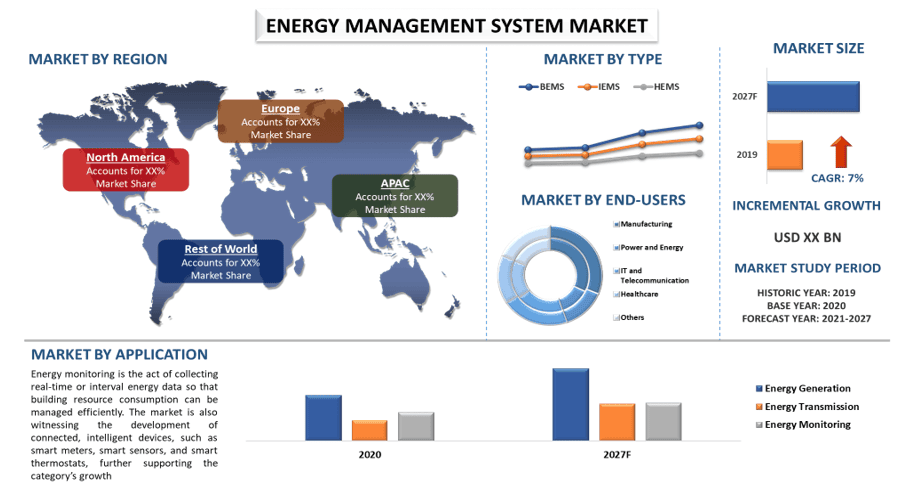- Home
- About Us
- Industry
- Services
- Reading
- Contact Us
Energy Management System Market: Current Analysis and Forecast (2021-2027)
Emphasis on Type (Building Energy Management System (BEMS), Industrial Energy Management Systems (IEMS), and Home Energy Management System (HEMS)); End-Users (Manufacturing, Power and Energy, IT and Telecommunication, Healthcare, and Others); Application (Energy Generation, Energy Transmission, and Energy Monitoring); and Region/Country

Rising investments in power transmission and distribution networks coupled with the growing augmentation and modernization of transmission and distribution networks across the globe are expected to drive the market. As per the United Nations Industrial Development Organization (UNIDO), an energy management system (EMS) is a framework for energy consumers, including industrial, commercial, and public sector organizations, to manage their energy use. It assists businesses in identifying opportunities to adopt and improve energy-saving technologies, including those that do not necessitate a large capital investment. In most cases, successful EMS implementation requires specialized knowledge and staff training. Thus, with the rising energy consumption coupled with the integration of mandatory environmental regulations and policies in the current energy management ecosystem, the global EMS market is expected to witness exponential growth during the forecast period.
The global energy management system market is expected to witness a CAGR of around 18% during the forecast period (2021–2027). Energy management is the process of tracking and optimizing energy consumption to conserve usage. Some of the features of EMS are collecting and analyzing continuous data, identifying optimizations in equipment schedules, setting points and flow rates to improve energy efficiency, calculating return on investment, and executing energy optimization solutions, among others. Thus, the EMS market is expected to witness exponential growth during the forecast period owing to the growing focus on energy conservation and management. Moreover, the surging consumption of electricity in developing countries are escalating the adoption of the smart grid coupled with the increasing need to upgrade existing infrastructure has positively influenced the market growth. In 2021, China witnessed an increase in electricity demand of 10%. This was mainly led by the industrial sector such as cement, construction, steel, and other metals, among others.
IBM Corporation, Rockwell Automation Inc., General Electric Co., Schneider Electric SE, Cisco Systems Inc., Tendril Networks Inc., Eaton Corporation, EnerNOC Inc., Elster Group GMBH, and SAP SE are some of the key players in the market. Several M&As along with partnerships have been undertaken by these players to facilitate customers with hi-tech and innovative products/technologies.
Insights Presented in the Report
“Amongst Type, BEMS category to hold significant share in the market”
Based on type, the market is classified into BEMS, IEMS, and HEMS. Amongst them, BEMS is expected to hold a significant market share by 2027. This is mainly due to the increased demand for building automation systems, rising global demand for energy-efficient electrical products coupled with an increase in urban population and industrialization activities. In addition, rising investments in power transmission and distribution networks coupled with the growing augmentation and modernization of transmission and distribution networks across the globe, are expected to drive the market. For instance, in February 2021, State Grid Corporation of China (SGCC) announced that it will spend an average of more than $70 billion a year (between 2021-2025) to upgrade the power grid to the “Energy Internet” and promote the transition to clean and low-carbon energy.
“Amongst End-Users, power and energy category is accounted for a significant market share in 2020”
Based on end-users, the market is classified into manufacturing, power and energy, it and telecommunication, healthcare, and others. Amongst them, the power and energy category is accounted for a significant market share in 2020. This is mainly due to the growing adoption and integration of EMS by utility companies, globally. For instance, SICAE Somme & Cambraisis, one of France’s regional electrical utilities, integrated EcoStruxure ADMS solution by Schneider Electric for its smart grid. This solution offers them a single tool for supervision, optimized grid management, simulation, effective scheduling of engineering work, incident management, and traceability. Furthermore, with the growing construction of high-rise residential as well as commercial buildings, the market is expected to witness tremendous growth opportunities during the forecast period. For instance, The Government of India in the Union Budget 2014-15, has announced a project to develop ‘One Hundred Smart Cities’ as satellite towns of larger cities by modernizing the existing mid-sized cities in the country,
“Amongst Application, energy monitoring category is expected to witness significant growth in the global energy management system market”
Based on application, the market is categorized into energy generation, energy transmission, and energy monitoring. During the forecast period, the energy monitoring category is expected to witness significant growth in the market owing to the increasing development of connected, intelligent devices, such as smart meters, smart sensors, and smart thermostats. Furthermore, major players in the market are focusing on various strategies such as partnering with local utility companies and entering the untapped and developing economies. For instance, in 2018, GE Power through its grid solutions collaborated with Tata Power Delhi Distribution (India) and launched a new Advanced Distribution Management Solution (ADMS), designed for India with advanced features, such as monitoring, security, analysis, and planning, enabling Tata Power-DDL to enhance the reliability, safety, and efficiency of state’s distribution network.
“APAC to witness significant growth during the forecast period”
Asia-Pacific is expected to witness the highest CAGR in the energy management system market, during the forecast period. The major contributors to the growth of this market are China, India, and Australia. The increase in infrastructure development in emerging economies, as well as the expansion of the commercial and industrial sector, coupled with the rise in installation and integration of smart devices, has contributed to the growth of the APAC market. Furthermore, factors such as growing investments in the up-gradation of old power transmission and distribution equipment and the growing development of smart cities are expected to support the market’s growth. In addition, an upsurge in renewable power generation projects is expected to positively influence the market demand for shunt reactors. For instance, in 2021, China’s total renewable energy capacity increased 10.2 percentage points as compared to 2015. The capacity exceeded 1,000 GW in 2021, according to the National Energy Administration, accounting for 43.5% of the country’s total power generation capacity.
Reasons to buy this report:
- The study includes market sizing and forecasting analysis validated by authenticated key industry experts.
- The report presents a quick review of overall industry performance at one glance.
- The report covers an in-depth analysis of prominent industry peers with a primary focus on key business financials, product portfolio, expansion strategies, and recent developments.
- Detailed examination of drivers, restraints, key trends, and opportunities prevailing in the industry.
- The study comprehensively covers the market across different segments.
- Deep dive regional level analysis of the industry.
Customization Options:
Global energy management system market can further be customized as per the requirement or any other market segment. Besides this, UMI understands that you may have your own business needs, hence feel free to connect with us to get a report that completely suits your requirements.
Table of Content
Analyzing the historical market, estimation of the current market, and forecasting the future market of the global energy management system market were the three major steps undertaken to create and analyze the adoption of energy management system in major regions globally. Exhaustive secondary research was conducted to collect the historical market numbers and estimate the current market size. Secondly, to validate these insights, numerous findings and assumptions were taken into consideration. Moreover, exhaustive primary interviews were also conducted, with industry experts across the value chain of the global energy management system market. Post assumption and validation of market numbers through primary interviews, we employed a top-down/bottom-up approach to forecasting the complete market size. Thereafter, market breakdown and data triangulation methods were adopted to estimate and analyze the market size of segments and sub-segments of the industry pertains to. Detailed methodology is explained below:
Seek More Details About Research Methodology
Analysis of Historical Market Size
Step 1: In-Depth Study of Secondary Sources:
Detail secondary study was conducted to obtain the historical market size of energy management system market through company internal sources such as annual report & financial statements, performance presentations, press releases, etc., and external sources including journals, news & articles, government publications, competitor publications, sector reports, third-party database, and other credible publications.
Step 2: Market Segmentation:
After obtaining the historical market size of the energy management system market, we conducted a detailed secondary analysis to gather historical market insights and share for different segments & sub-segments for major regions. Major segments included in the report as type, end-users, and application. Further country-level analyses were conducted to evaluate the overall adoption of testing models in that region.
Step 3: Factor Analysis:
After acquiring the historical market size of different segments and sub-segments, we conducted a detailed factor analysis to estimate the current market size of the energy management system market. Further, we conducted factor analysis using dependent and independent variables such as various type, end-users, and application of energy management system equipment. A thorough analysis was conducted for demand and supply-side scenarios considering top partnerships, merger and acquisition, business expansion, and product launches in the Energy management system market sector across the globe.
Current Market Size Estimate & Forecast
Current Market Sizing: Based on actionable insights from the above 3 steps, we arrived at the current market size, key players in the global energy management system market, and market shares of the segments. All the required percentage shares split, and market breakdowns were determined using the above-mentioned secondary approach and were verified through primary interviews.
Estimation & Forecasting: For market estimation and forecast, weights were assigned to different factors including drivers & trends, restraints, and opportunities available for the stakeholders. After analyzing these factors, relevant forecasting techniques i.e., top-down/bottom-up approach was applied to arrive at the market forecast about 2027 for different segments and sub-segments across the major markets globally. The research methodology adopted to estimate the market size encompasses:
- The industry’s market size, in terms of revenue (USD) and the adoption rate of energy management system market across the major markets domestically
- All percentage shares, splits, and breakdowns of market segments and sub-segments
- Key players in the global energy management system market in terms of solutions offered. Also, the growth strategies adopted by these players to compete in the fast-growing market
Market Size and Share Validation
Primary Research: In-depth interviews were conducted with the Key Opinion Leaders (KOLs) including Top Level Executives (CXO/VPs, Sales Head, Marketing Head, Operational Head, and Regional Head, Country Head, etc.) across major regions. Primary research findings were then summarized, and statistical analysis was performed to prove the stated hypothesis. Inputs from primary research were consolidated with secondary findings, hence turning information into actionable insights.
Split of Primary Participants in Different Regions

Market Engineering
Data triangulation technique was employed to complete the overall market estimation and to arrive at precise statistical numbers of each segment and sub-segment of the global energy management system market. Data was split into several segments & sub-segments post studying various parameters and trends in the areas of type, end-users, and application in the global energy management system market.
The main objective of the global energy management system Market Study
The current & future market trends of global energy management system market were pinpointed in the study. Investors can gain strategic insights to base their discretion for investments from the qualitative and quantitative analysis performed in the study. Current and future market trends were determined the overall attractiveness of the market at a regional level, providing a platform for the industrial participant to exploit the untapped market to benefit as a first-mover advantage. Other quantitative goals of the studies include:
- Analyze the current and forecast market size of the energy management system market in terms of value (USD). Also, analyze the current and forecast market size of different segments and sub-segments
- Segments in the study include areas of type, end-users, and application.
- Define and analysis of the regulatory framework for the energy management system market industry.
- Analyze the value chain involved with the presence of various intermediaries, along with analyzing customer and competitor behaviors of the industry.
- Analyze the current and forecast market size of the energy management system market for the major region.
- Major countries of regions studied in the report include Asia Pacific, Europe, North America, and Rest of the world.
- Company profiles of the energy management system market and the growth strategies adopted by the market players to sustain in the fast-growing market
- Deep dive regional level analysis of the industry
Related Reports
Customers who bought this item also bought










